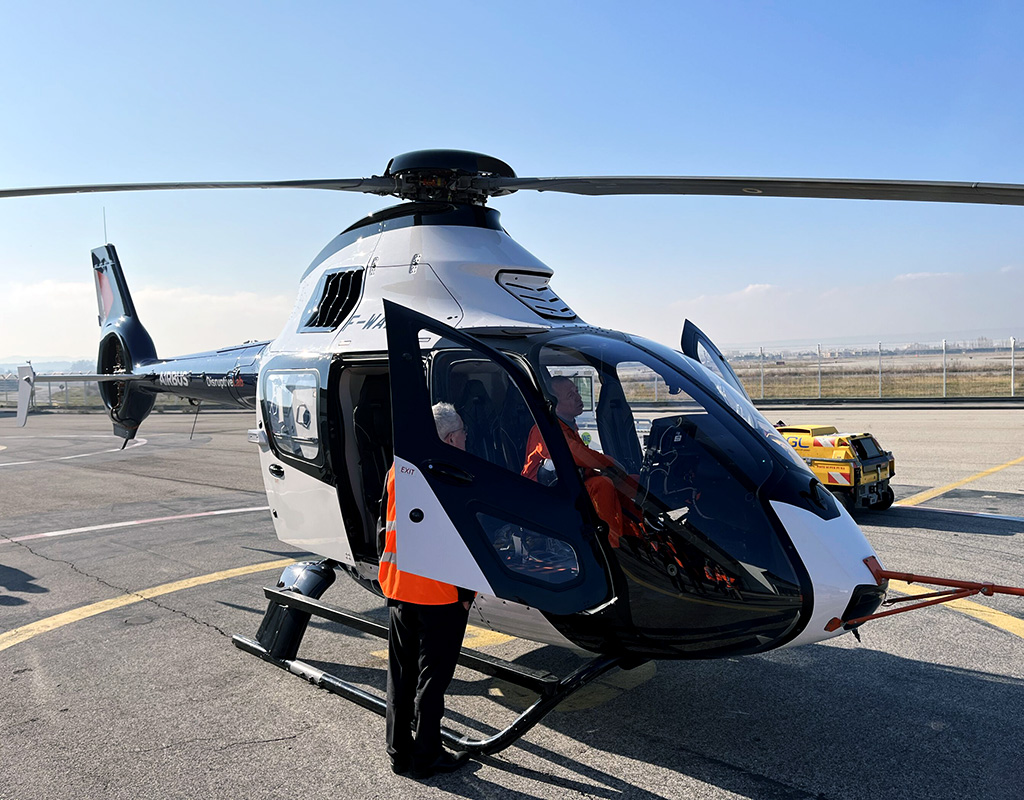
Airbus Helicopters is now performing weekly flight tests of its DisruptiveLab demonstrator, as it works to confirm the improved performance and reduction in emissions the aircraft has been designed to achieve.
Unveiled in November 2022 during its parent company’s annual summit in Toulouse, France, the aircraft targets a 50 percent reduction in fuel consumption through a new aerodynamic architecture, a modified thermal engine, and use of a 250 kW electric motor for a hybrid propulsion system.
The aircraft first flew in January 2022, and has since completed five flights. The most recent, flown on Feb. 14, lasted just over an hour.
“The target is not to fly too often, but to fly in the clever way to draw the [right] conclusions,” Tomasz Krysinski, the company’s head of research and technology, told reporters during a briefing at Airbus Helicopters’ headquarters in Marignane, France. “We fly it every week, we then process the data, we have always the meeting with the crew after the flight, [and] after processing the data, we fix what we do for the next flight.”
Krysinski said the company believed the demonstrator’s aerodynamic design could mean the aircraft requires up to 15 percent less power in forward flight. That design was arrived at after Airbus completed 40 wind tunnel campaigns, and Krysinski said the integration of the main rotor is key.
This is achieved with a specific inter-blade damper concept that allows the hub to be very compact and close to the aircraft’s body. The result is 40 percent less drag than previous generations of helicopters, said Krysinski.
“Really the integration of the hub with this integrated concept is key to help the low-drag design, and here is the most, I would say, clever way to reduce the CO2 emissions,” he said. ”We don’t need any specific other devices — it’s just done by the design.”
In addition to being a more efficient aircraft, Krysinski said DisruptiveLab is much quieter. One of the reasons for this is the design of its three main rotor blades. They have a thin profile on the tip, and a lower rotation tip speed.
They also have a bigger chord and are longer in relation to the size of the demonstrator than a typical aircraft in Airbus’s fleet. DisruptiveLab’s rotor disc has a diameter of 38 feet (11.6 meters), which represents a 7 to 8 percent increase in size over previous generation aircraft. “More radius means less power required,” explained Krysinski.
The blades also provide a reduction in vibrations, he added. ”Already our crew notices it — it is a very smooth flight. [DisruptiveLab] will make the breakthrough . . . in terms of vibrations.”
Behind the main cabin, a “simplified” tail cone leads to a heavily modified Fenestron tail rotor. The number of pieces in the Fenestron was halved, with the integration of parts allowing for a smaller hub and reduction in the system’s overall diameter.
Finally, the landing gear has been integrated into the aircraft’s body through just three points — two either side at the front, and one in the rear in the middle.
The fuselage is made from aluminum and composite materials (from Airbus Atlantic and Rexiaa, respectively), and everything on the aircraft is scalable, said Krysinski.
A modified powertrain
The second element in the system’s drive to efficiency is its thermal engine, which has been provided by Safran Helicopter Engines, with a target of a 25 percent reduction in fuel burn.
“It’s a bit of a revolution,” said Krysinski, without providing further details. “It’s a completely new design, and we really want to make a disruption.”
Finally, the aircraft has been built for hybridization — which has the potential to provide a reduction of 10 percent in fuel burn.
The motor will allow “reversable hybridization” said Krysinski. Much like the electric motor in a hybrid car, it will be capable of being charged through a plug-in port or by the turbine engine during some flight conditions. In other flight conditions, energy can be taken from the electric motor and put into the powertrain.
The 250 kW motor will be capable of powering the rotors for three minutes in horizontal flight, said Krysinski. But while safety is clearly one benefit in case of engine loss, he said there the use of the electric motor “opens the doors to many subjects” — such as perhaps the potential to enter urban areas with a single-engine aircraft.

He also highlighted the potential for the motor to provide a performance boost for high altitude operations.
While the electric motor has not been installed yet (and a manufacturer has not been chosen), the aircraft is ready to receive it — no further customization is required. The company expects to test the hybridization aspects in 2024.
“[Because] everything is really integrated, you can reduce [the] number of interfaces and you can reduce the weight of the system,” said Krysinski.
The global 50 percent reduction in fuel burn “opens the doors” to wide use of sustainable aviation fuel (SAF), he added, as it offsets the fuel’s increased expense.
It also serves as a further step towards making the use of hydrogen fuel cells a possibility.
“Everything we are doing is really to prepare sustainable aviation fuels and prepare also the new world of [the] ‘hydrogen revolution,’ ” he said.
The speed of the DisruptiveLab’s development has been impressive, and Krysinski paid tribute to the funding the company has received from the French civil aviation authority as part of the French stimulus plan.
“There was a strong acceleration from 2020 with this stimulus plan,” he said.
The aircraft is one of two technology demonstrators at Airbus Helicopters. Its FlightLab demonstrator, launched in 2020, is researching “technobricks” related to enhanced autonomy and safety using an H130 as the base platform.
“On FlightLab, we tested a lot of things that . . . we can retrofit on the current fleet,” said Krysinski. “DisruptiveLab was designed to test new architectures as a demonstrator and concept helicopter.”

